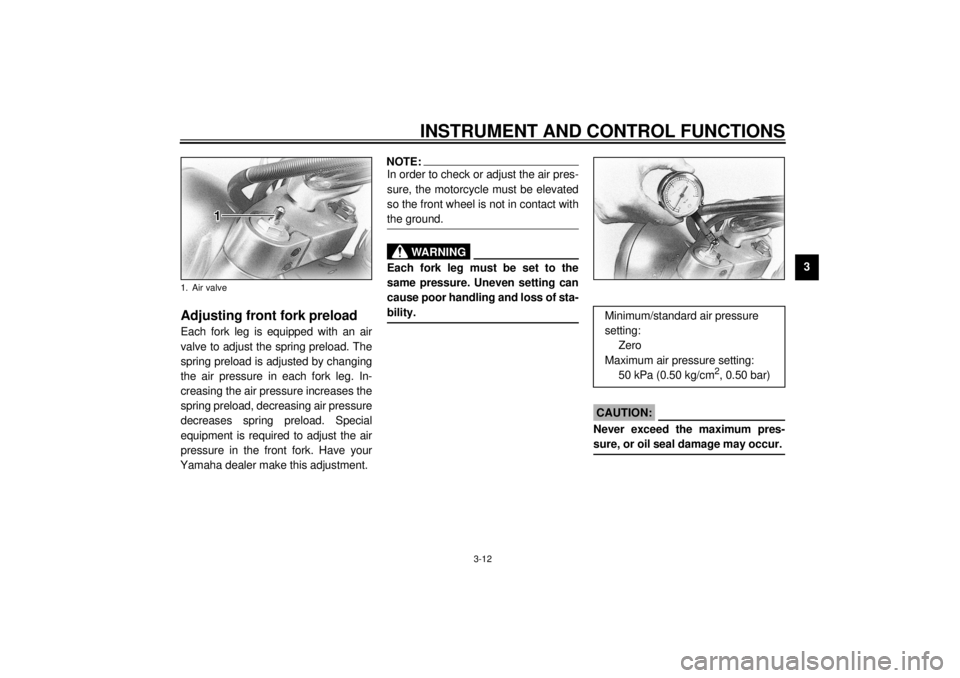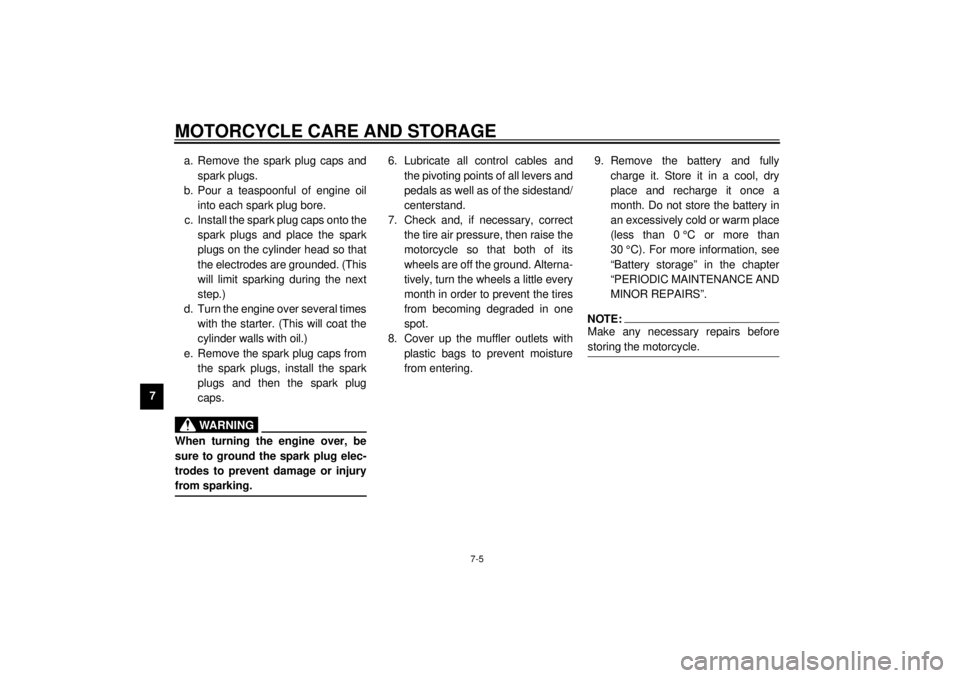Page 26 of 91

INSTRUMENT AND CONTROL FUNCTIONS
3-12
3
EAU01605
Adjusting front fork preloadEach fork leg is equipped with an air
valve to adjust the spring preload. The
spring preload is adjusted by changing
the air pressure in each fork leg. In-
creasing the air pressure increases the
spring preload, decreasing air pressure
decreases spring preload. Special
equipment is required to adjust the air
pressure in the front fork. Have your
Yamaha dealer make this adjustment.
NOTE:@ In order to check or adjust the air pres-
sure, the motorcycle must be elevated
so the front wheel is not in contact with
the ground. @
EW000037
WARNING
@ Each fork leg must be set to the
same pressure. Uneven setting can
cause poor handling and loss of sta-
bility. @
EC000012
CAUTION:@ Never exceed the maximum pres-
sure, or oil seal damage may occur. @
1. Air valve
Minimum/standard air pressure
setting:
Zero
Maximum air pressure setting:
50 kPa (0.50 kg/cm
2, 0.50 bar)
E_4YP_Functions.fm Page 12 Wednesday, October 6, 1999 10:03 AM
Page 31 of 91

4-1
4
EAU01114
4-PRE-OPERATION CHECKSOwners are personally responsible for their vehicle’s condition. Your motorcycle’s vital functions can start to deteriorate
quickly and unexpectedly, even if it remains unused (for instance, if it is exposed to the elements). Any damage, fluid leak or
loss of tire pressure could have serious consequences. Therefore, it is very important that, in addition to a thorough visual in-
spection, you check the following points before each ride.
EAU00340
PRE-OPERATION CHECK LIST
ITEM CHECKS PAGE
Front brake• Check operation, fluid level and vehicle for fluid leakage.
• Fill with DOT 4 brake fluid if necessary.
6-17 ~ 6-21
Rear brake• Check operation, fluid level and vehicle for fluid leakage.
• Fill with DOT 4 brake fluid if necessary.
Clutch• Check operation, fluid level and vehicle for fluid leakage.
• Fill with DOT 4 brake fluid if necessary.6-16
Throttle grip and housing• Check for smooth operation.
• Lubricate if necessary.6-12
Engine oil• Check oil level.
• Fill with oil if necessary.6-7 ~ 6-9
Coolant reservoir tank• Check coolant level.
• Fill with coolant if necessary.6-10 ~ 6-11
Final gear oil• Check vehicle for leakage. 6-10
Wheels and tires• Check tire pressure, wear and for damage. 6-13 ~ 6-16
Brake and shift pedal
shafts• Check for smooth operation.
• Lubricate if necessary.6-21
Brake and clutch lever
pivots• Check for smooth operation.
• Lubricate if necessary.6-22
Sidestand pivot• Check for smooth operation.
• Lubricate if necessary.6-22
E_4YP_Preop.fm Page 1 Wednesday, October 6, 1999 10:04 AM
Page 46 of 91

PERIODIC MAINTENANCE AND MINOR REPAIR
6-4
6
10
*Tires• Check tread depth and for damage.
• Replace if necessary.
• Check air pressure.
• Correct if necessary.ÖÖ
11*Wheel bearings• Check bearing for looseness or damage.
• Replace if necessary. ÖÖ
12*Swingarm• Check swingarm pivoting point for play.
• Correct if necessary.
• Lubricate with molybdenum disulfide grease every 24,000 km or
24 months (whichever comes first).ÖÖ
13*Steering bearings• Check bearing play and steering for roughness.
• Correct accordingly.
• Lubricate with lithium soap base grease every 24,000 km
or 24 months (whichever comes first).ÖÖ
14*Chassis fasteners• Make sure that all nuts, bolts and screws are properly tightened.
• Tighten if necessary.ÖÖ
15 Sidestand• Check operation.
• Lubricate and repair if necessary.ÖÖ
16*Sidestand switch• Check operation.
• Replace if necessary.ÖÖÖ
17*Front fork• Check operation and for oil leakage.
• Correct accordingly.ÖÖ
18*Rear shock absorber
assembly• Check operation and shock absorber for oil leakage.
• Replace shock absorber assembly if necessary. ÖÖ
19*Rear suspension relay
arm and connecting arm
pivoting points• Check operation.
• Lubricate with molybdenum disulfide grease every 24,000 km or
24 months (whichever comes first).ÖÖ NO. ITEM CHECKS AND MAINTENANCE JOBSINITIAL
(1,000 km)EVERY
6,000 km
or
6 months
(whichever
comes first)12,000 km
or
12 months
(whichever
comes first)
* Since these items require special tools, data and technical skills, they should be serviced by a Yamaha dealer.
E_4YP_Periodic.fm Page 4 Wednesday, October 6, 1999 10:05 AM
Page 79 of 91

MOTORCYCLE CARE AND STORAGE
7-5
7a. Remove the spark plug caps and
spark plugs.
b. Pour a teaspoonful of engine oil
into each spark plug bore.
c. Install the spark plug caps onto the
spark plugs and place the spark
plugs on the cylinder head so that
the electrodes are grounded. (This
will limit sparking during the next
step.)
d. Turn the engine over several times
with the starter. (This will coat the
cylinder walls with oil.)
e. Remove the spark plug caps from
the spark plugs, install the spark
plugs and then the spark plug
caps.
EWA00003
WARNING
@ When turning the engine over, be
sure to ground the spark plug elec-
trodes to prevent damage or injury
from sparking. @
6. Lubricate all control cables and
the pivoting points of all levers and
pedals as well as of the sidestand/
centerstand.
7. Check and, if necessary, correct
the tire air pressure, then raise the
motorcycle so that both of its
wheels are off the ground. Alterna-
tively, turn the wheels a little every
month in order to prevent the tires
from becoming degraded in one
spot.
8. Cover up the muffler outlets with
plastic bags to prevent moisture
from entering.9. Remove the battery and fully
charge it. Store it in a cool, dry
place and recharge it once a
month. Do not store the battery in
an excessively cold or warm place
(less than 0 °C or more than
30 °C). For more information, see
“Battery storage” in the chapter
“PERIODIC MAINTENANCE AND
MINOR REPAIRS”.
NOTE:@ Make any necessary repairs before
storing the motorcycle. @
E_4YP_Cleaning.fm Page 5 Wednesday, October 6, 1999 10:06 AM
Page 83 of 91

SPECIFICATIONS
8-3
8
Maximum load* 203 kg
Air pressure (cold tire)
Up to 90 kg load*
Front 250 kPa (2.50 kg/cm
2, 2.50 bar)
Rear 250 kPa (2.50 kg/cm2, 2.50 bar)
90 kg load ~ maximum load*
Front 250 kPa (2.50 kg/cm2, 2.50 bar)
Rear 280 kPa (2.80 kg/cm2, 2.80 bar)
* Load is the total weight of cargo, rider, passenger and accesso-
ries.
Wheels
Front
Ty p e C a s t
Size 16 ´ MT3.50
Rear
Ty p e C a s t
Size 15M/C ´ MT4.00
Brakes
Front
Type Dual disc brake
Operation Right hand operation
Fluid DOT 4Rear
Type Single disc brake
Operation Right foot operation
Fluid DOT 4
Suspension
Fr o n t
Ty p e Te l e s c o p i c f o r k
Rear
Type Swingarm (link suspension)
Shock absorber
Front Coil-air spring / oil damper
Rear Coil spring / gas-oil damper
Wheel travel
Front 140 mm
Rear 95 mm
Electrical sysyem
Ignition system T.C.I. (digital)
Charging system
Type A.C. magneto
Standard output 14 V, 23 A @ 5,000 r/min
Battery
Type YTX20L-BS
Voltage, capacity 12 V, 18 AH
E_4YP_Spec.fm Page 3 Wednesday, October 6, 1999 10:06 AM